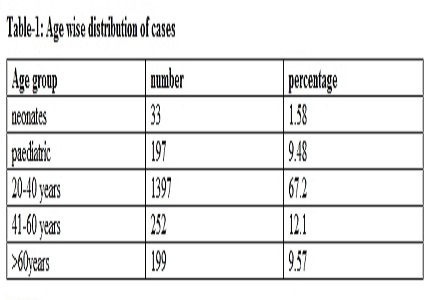Nitrofurantoin susceptibility of ESBL gram negative isolates from patients with urinary tract infection (UTI) in a rural teaching hospital of Telangana
Abstract
Introduction: Urinary tract infections (UTI) are the most common bacterial infections affecting humans throughout their lifetime. Escherichia coli are the most common pathogen in UTIs. Extended Spectrum Beta lactamase (ESBL)-producing E. coli-related UTI is an emerging problem in many parts of the world. Nitrofurantoin has been used for a long time, but the emergence of antibiotic resistance and the decline in newly developed antibiotics has increased interest in treatment of bacterial UTI with this antibiotic.
Materials & methods: A descriptive analysis of culture results of urine samples was performed at Microbiology department of MediCiti Institute of Medical Sciences from October 2014 to September 2015. Clean-catch midstream morning urine specimens were collected using sterile wide mouth disposable plastic container. The specimens were inoculated on nutrient agar, blood agar, and MacConkey agar plates and incubated aerobically at 37°C for 24-48 hours. Culture plates with colony counts of ≥ 105 colony forming units (CFU) were considered positive for UTI. Antimicrobial susceptibility was performed according to CLSI guidelines.
Results: A total of 2078 cases were included in the study, out of which 485(23.33%) were males and 1593 (76.66%) females. Male to female ratio was 1:3.2. Majority of the cases (67.2%) belonged to age group 20-40 years. Escherichia coli (E.coli) (60.58%) was the most common pathogen among Gram negative isolates. 153 ESBL’S (49.83%) were reported in this study. Among these 153 isolates of ESBL producer’s nitrofurantoin resistance was seen in 44 (28.75%) isolates.
Conclusion: E.coli remained the predominant isolate among gram negative organisms, more commonly in females presenting to our hospital. The in vitro activity of Nitrofurantoin found in the present study suggests that this drug would provide adequate fluoroquinolones sparing alternative therapy at places where Cotrimoxazole use is no longer prudent because of high rates of resistance. This study shows that nitrofurantoin can be used even for drug resistant strains.
Downloads
References
2. Coskun O, Erdem H, Avcı A. Management of community-acquired acute bacterial cystitis in Turkey. Turk J Med Sci 2011; 41(1):149–57.
3. Spencer RC, Moseley DJ, Greensmith MJ. Nitrofurantoin modified release versus trimethoprim or co-trimoxazole in the treatment of uncomplicated urinary tract infection in general practice. J Antimicrob Chemother. 1994 May;33 Suppl A:121-9. [PubMed]
4. Ozlem KA Hande A. Risk factors for ciprofloxacin resistance among Escherichia coli strains isolated from community acquired urinary tract infections in turkey. J Antimicrobial Chemother. 2005; 56(5):914-918.
5. J.G.Colle, R.S.Miles, B.Watt. Tests for Identification of bacteria. Mackie and Mc Cartney Practical Medical Microbiology 14th edition, Churchill Livingstone 2008: P131-149. [PubMed]
6. KASS EH. Bacteriuria and the diagnosis of infections of the urinary tract; with observations on the use of methionine as a urinary antiseptic. AMA Arch Intern Med. 1957 Nov;100(5):709-14. [PubMed]
7. Clinical Laboratory Standard Institute. Performance Standards for Antimicrobial Susceptibility Testing; Twenty-Second Informational Supplement. Vol. 32. Clinical Laboratory Standard Institute; Wayne, Pennsylvania, USA: 2012. pp. 70–71.
8. Gupta K, Hooton TM, Naber KG, Wullt B, Colgan R, Miller LG et al. International clinical practice guidelines for the treatment of acute uncomplicated cystitis and pyelonephritis in women: A 2010 update by the Infectious Diseases Society of America and the European Society for Microbiology and Infectious Diseases. Clin Infect Dis 2011; 52(5): 103–20. [PubMed]
9. Khoshbakht R, Salimi A, Aski HS, Keshavarzi H. Antibiotic susceptibility of bacterial strains isolated from urinary tract infections in Karaj,Iran. Jundishapur J Microbiol 2013; 6(1):86-90.
10. Shalini, Joshi MC, Rashid MK, Joshi HS. Study of Antibiotic Sensitivity Pattern in Urinary Tract Infection at a Tertiary Hospital. Nat J Integr Res Med 2011; 2(3):43-6.
11. Kibret M, Abera B. Prevalence and antibiogram of bacterial isolates from urinary tract infections at Dessie Health Research Laboratory, Ethiopia.Asian Pac J Trop Biomed 2014; 4(2): 164-68.
12. Rijal A, Ghimire G, Gautam K, Barakoti A. Antibiotic Susceptibility of Organisms Causing Urinary Tract Infection in Patients Presenting to a Teaching Hospital. J Nepal Health Res Counc 2012; 10(20):24-27.
13. James AK, Laurie J, Clyde T, Mark EJ, Daniel FS. Trends in Antimicrobial Resistance among Urinary Tract Infection Isolates from Female Outpatients in the United States. Antimicrob Agents Chemother 2002; 46(8): 2540-45.



 OAI - Open Archives Initiative
OAI - Open Archives Initiative


